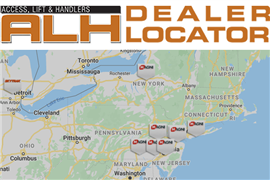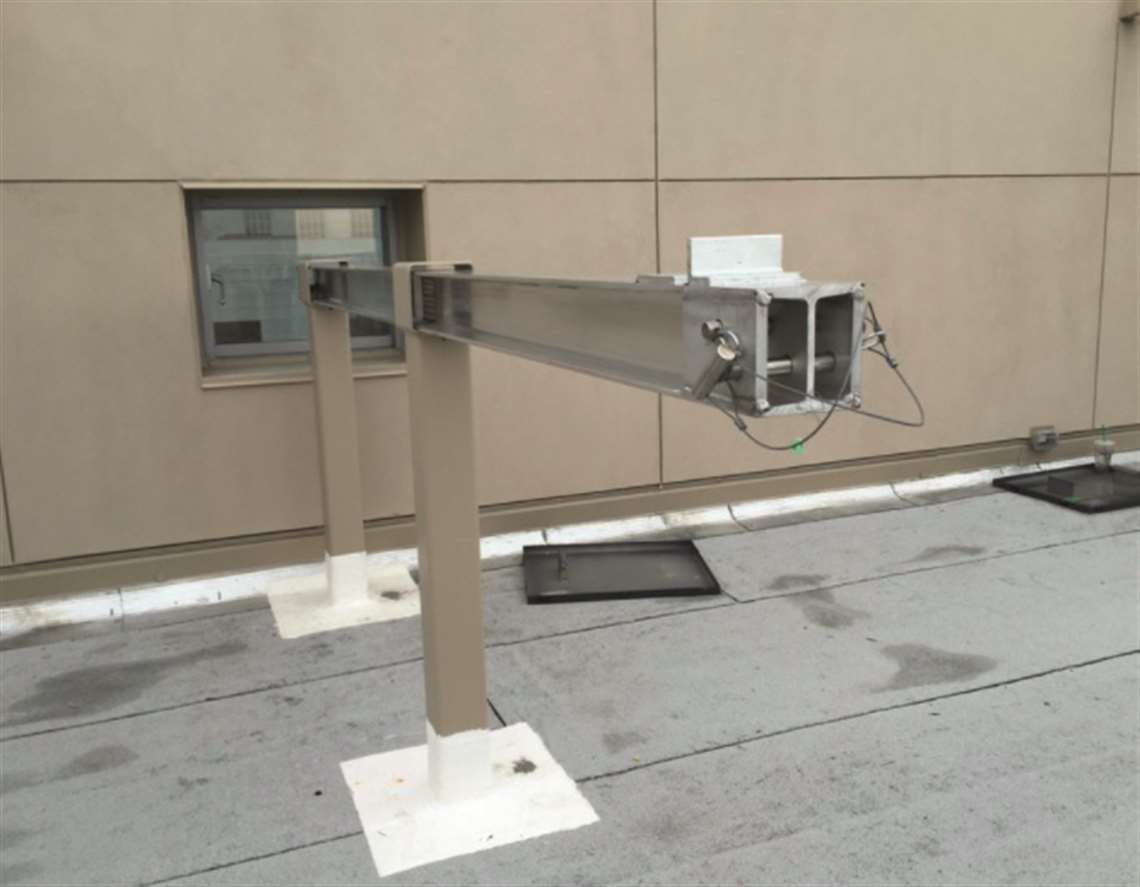Permanent Installation 101: Outrigger systems
November 06, 2023
Industry expert Brian Andrews discusses outrigger systems and how they factor into Permanently Installed support systems.
As discussed in the previous Permanent Installation (PI) Council article (SA Magazine, May/June 2022), one of the many types of PI support systems is called an outrigger system.
 A backfed fixed outrigger system. (All photos: Bee Access)
A backfed fixed outrigger system. (All photos: Bee Access)
An outrigger system consists of an I-beam or tube that is projected beyond the building’s façade and supports the raising and lowering of suspended access equipment, or material, from the ground or a lower roof level.
Outriggers are traditionally transportable so they can be moved from one location to another on the building or structure. Once in position, the outrigger is secured to the building/structure by means of permanently installed stands or anchors.
Outriggers are designed, constructed, and operated in accordance with established safety regulations and standards including OSHA 1910.66 and ASME A-120.1. These standards contain specific requirements for the use of outriggers, including the need for regular inspections, maintenance and testing to ensure that they remain safe and operational.
Proper training and guidance for workers who use outriggers is also critical to minimizing the risk of accidents, injury, or death. This training should cover all aspects of the safe use of outriggers, including how to set up and operate these devices, how to conduct regular inspections and how to respond to emergency situations.
PI Outrigger systems are made up of three categories: Transportable non-counterweighted, fixed and push-thru.
Within the transportable non-counterweighted outrigger system and fixed outrigger system categories, there are two different styles of outriggers.
The style of outrigger is based on where the suspension wire rope is terminated and is either called a backfed or I-beam style outrigger system. The suspension rope is typically attached to the front of an outrigger beam. This type of outrigger system would be an I-beam style.
 An I-Beam style transportable non-counterweighted outrigger system.
An I-Beam style transportable non-counterweighted outrigger system.
However, backfed outriggers allow the suspension rope to be secured to the rear portion of the tube and the tip of the rope is fed through the tube and down to the ground. In general, backfed type outriggers allow for easier and safer wire-rope installation and removal.
Transportable Non-Counterweighted Outrigger Systems
Transportable non-counterweighted outrigger systems oftentimes look identical to those used for temporary platforms; however, these do not utilize counterweights. instead, these systems are secured directly down to an anchor.
These types of systems are typically made of aluminum or steel and have a frame with casters on the front to easily transport the outrigger beam from one location on the building/structure to another.
Transportable non-counterweighted outrigger systems can be backfed or I-beam style depending on the suspended platform’s location requirements.
Fixed Outrigger Systems
Fixed outrigger systems are beams that slide into fixed stands located on the building or structure. They can also be either backfed or I-beam style depending on the required locations, however, the majority of the time, these types of outrigger systems are backfed. The beams are oftentimes capable of being broken down and transported from one location to another on the building or structure.
 A push-thru outrigger system.
A push-thru outrigger system.
Push-Thru Outrigger Systems
Push-thru outrigger tubes slide through stands or sleeves permanently installed in the wall of the building or structure and project beyond the building’s façade. Once in position, the suspension wire rope is secured to the rear portion of the outrigger and the tip of the rope is fed through the tube to the ground. Because of this, all push-thru outriggers are backfed which allows for easier and safer wire-rope installation and removal.
As with fixed outrigger beams, push-thru outrigger tubes are often transported from one location to another on the building or structure.
In short, outrigger systems are one type of a Permanently Installed support system within the exterior building maintenance industry.
They provide workers stable and safe access to the exterior of the building or structure for maintenance and repair work.
By following the established safety regulations and standards along with the proper training, workers can minimize the risk of accidents, injury or death, ensuring a safer and more efficient work environment for everyone involved.
Codes pertaining to Outrigger Systems are as follows (but are not limited to):
- OSHA 1910.66
- ANSI A120
- IWCA I-14
PI Council mission
The mission of the PI Council is to improve the knowledge of all those involved with the design, construction, use, inspection, maintenance and service of permanently installed suspended scaffolding. Most notably window washing scaffolds, Façade Maintenance Units (FMU), Building Maintenance Units (BMU) and rolling gantries.
PI Council goals:
- Develop a video demonstrating the safe and proper use of davits. This is to include raising, lowering, dismantling and transporting davits.
- Complete and publish service/inspection check list.
- Educate the members of the SAIA and scaffold users of the key differences between temporary and permanent suspended scaffolds. With emphasis on how the codes that govern each differ.
- Inspection protocols (for Technicians) – PI scaffolds.
To learn more about the PI Council or the Scaffold & Access Industry Association, visit www.saiaonline.org/permanentinstallation or www.saiaonline.org.
About the author
Brian Andrews is the vice president of engineering at Bee Access Products and chair of the Scaffold & Access Industry Association (SAIA) Permanent Installation Council. Contact him at [email protected].
STAY CONNECTED



Receive the information you need when you need it through our world-leading magazines, newsletters and daily briefings.
CONNECT WITH THE TEAM










